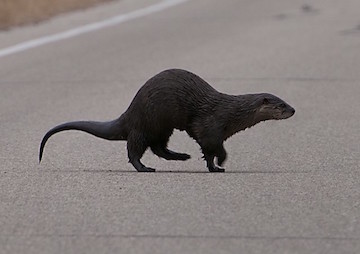Wildlife Needs New Corridors to Escape Rising Heat
Rising temperatures will force wild creatures to seek cooler refuges -- but safe routes for them to migrate may be scarce, scientists say. An otter tries to cross a road. Hard times are ahead for species that can find no safe passage to habitat. (Mandcrobertson via Wikimedia Commons)
An otter tries to cross a road. Hard times are ahead for species that can find no safe passage to habitat. (Mandcrobertson via Wikimedia Commons)
By Tim Radford / Climate News Network
An otter tries to cross a road. Hard times are ahead for species that can find no safe passage to habitat. (Mandcrobertson via Wikimedia Commons)
The piece first appeared at Climate News Network.
LONDON — US scientists worried about what global warming and climate change may do to wildlife have come up with the ultimate in creature-friendly versions of road maps or highway patrols.
They want to see natural corridors that link safe habitats and ecosystems, so that as conditions change, plants and animals — and the continental US is home to 800 species of bird, more than 400 kinds of mammal and more than 600 reptiles and amphibians — get a chance to migrate.
And, they report, only 2% of the eastern US offers the climate connectivity — their word for it — that could deliver the slow, safe passage that the native flora and fauna need to cope with shifts in temperature and changing rainfall patterns.
For decades, ecologists have been worried about what climate change will do for creatures that have evolved to flourish in a range of suitable habitats. They have warned that many wild things — already threatened by pollution, hunting and habitat destruction — could be pushed closer to extinction and have separately made the case for, for example, mammals in Borneo, birds in America and trees everywhere.
Concrete obstacles
And increasing urbanisation presents a new hazard: creatures that start to lose parts of their range in the south may not be able to migrate north because vast conurbations, linked by tarmacadam and pavement, and screened by industrial zones and intensively farmed land, block the way.
Jenny McGuire, a biologist at Georgia Institute of Technology, and colleagues report in the Proceedings of the National Academy of Sciences that they looked at the problem of escape routes for creatures that will need to shift their ground with the gradual shift in climate.
Around 45% of the contiguous US is “natural.” The Western US is a landscape of mountain chains, prairie, high plains and forested coasts, pockmarked with desert regions, and a procession of national parks. The connectivity rating there is as high as 41%.
But the Georgia team’s “climate linkage mapper toolbox” told a different story for the eastern states. Any serious attempt to give wildlife room to adjust would involve restoring natural habitats and forests in ways that linked potential refuges and safe spots.
“A lot of them are going to have a hard time. We have a high diversity of amphibians and other species that are going to struggle.”
The solution demands some joined-up thinking. Birds can fly to new homes. But carnivores need to follow prey, and herbivores need to move with their preferred plants. Amphibians and reptiles will have problems even crossing roads.
“A lot of them are going to have a hard time,” Dr McGuire said. “For plants and animals in the East, there is a higher potential for extinction due to an inability to adapt to climate change. We have a high diversity of amphibians and other species that are going to struggle.”
The next step is to work out which creatures are most at risk, and which stretches of land are likely to become unsatisfactory habitat as human numbers grow and demands expand.
“We see a lot of species’ distributions really start to wink out after about 50 years, but it is tricky to look at future predictions because we will have a lot of habitat loss predicted using our models,” McGuire said. “Change is perpetual, but we are going to have to scramble to prepare for this.”
Tim Radford, a founding editor of Climate News Network, worked for The Guardian for 32 years, for most of that time as science editor. He has been covering climate change since 1988.
Your support matters…Independent journalism is under threat and overshadowed by heavily funded mainstream media.
You can help level the playing field. Become a member.
Your tax-deductible contribution keeps us digging beneath the headlines to give you thought-provoking, investigative reporting and analysis that unearths what's really happening- without compromise.
Give today to support our courageous, independent journalists.






You need to be a supporter to comment.
There are currently no responses to this article.
Be the first to respond.